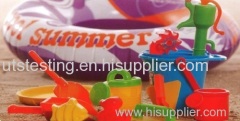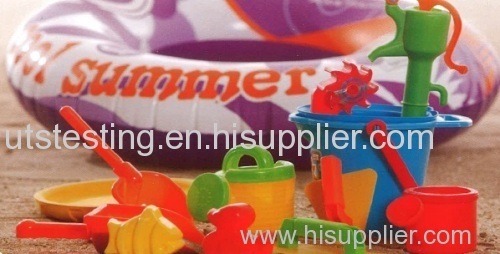Safety of toys is cirtically important for consumers and our society, especially for children and juveniles. With social progress, industrial development and cultural change, it takes a huge change for toy design and production. All kinds of toy regulations and standards also upgrate and develop. With frequent toy safety issues in recent years, every country has established more and more strict regulations and standards for toys.
Toy Test Standard for Various Country
ISO International: ISO 8124
China:GB 6675 GB19865
EU: EN71, EN 62115, EMC
USA:CPSC, ASTM F963, FDA
Canada: CHPA
UK:BS EN71
Germany: DIN EN 71, DIN EN 62115, LFGB
France: NF EN 71, NF EN 62115
Australia: AS/NZS ISO 8124, EMC
New Zealand:NZS 5822, AS/NZS ISO 8124
Japan: ST 2002
INTERNATIONAL TOYS SAFETY STANDARDS REQUIREMENTS
Testing Item | EU | Germany | France | USA | Canada | Australia/New Zealand | China |
Physical and mechanical properties testing | EN71-1 | DIN EN71-1 | DIN EN71-1 | 16 CFR 1500 ASTM F963 | Hazardous Products(Toys) Regulations | AS/NZS ISO 8124-1 | GB 6675 Appendix A |
Flammability testing (textile materials) | EN71-2 | DIN EN71-2 | DIN EN71-2 | 16 CFR 1610 ASTM F963 | Hazardous Products(Toys) Regulations | AS/NZS ISO 8124-2 | GB 6675 Appendix B |
Flammability testing (other materials) | EN71-2 | DIN EN71-2 | DIN EN71-2 | 16 CFR 1500.44 ASTM F963 | Canada Hazardous Products Act | AS/NZS ISO 8124-2 | GB 6675 Appendix B |
Toxic element heavy (metal analysis) | EN71-3 | DIN EN71-3 | DIN EN71-3 | 16 CFR 1303 ASTM F963 | Canada Hazardous Products Act | AS/NZS ISO 8124-3 | GB 6675 Appendix C |
Toxic element heavy (total lead, Cd, Hg) | EN1122 | 16 CFR 1303 CPSIA | Hazardous Products(Toys) Regulations | ||||
Filler clean testing | EN71-1 | DIN EN71-1 | DIN EN71-1 | ASTM F963 | Hazardous Products(Toys) Regulations | AS/NZS ISO 8124-1 | GB 6675 Appendix A |
Labels and instructions | EN71-1 | DIN EN71-2 | DIN EN71-1 | 16 CFR 1500 ASTM F963 | Hazardous Products(Toys) Regulations | AS/NZS ISO 8124-1
| GB 5296.5 |
Phthalate content | REACH regulations | REACH regulations | REACH regulations | CPSIA | Australia Trade Practice Acts | GB 24613 | |
AZO dyes | REACH regulations | REACH regulations | REACH regulations | GB 18401 | |||
Electronic toys testing | EN62115 | C22.2 No.149-1972 | AS/NZS ISO 8124-1 IEC62115 | GB 19865 | |||
Electromagnetic compatibility | EU directives 2004/108/EC | EU directives 2004/108/EC | EU directives 2004/108/EC | FCC PART 15 | ICES-003 | AS/NZS CISPR 14.1 | GB 4343.2 |
With rich experience, UTS can provide "one-stop" testing service for all kinds of toys and juvenile products, including functional evaluation, safety performance testing and chemical safety testing and also technical consulting service.
Toys-Comprehensive Testing Service
Testing Item | Stuffed Toys | Eletronic Toys | Plastic Toys | Wood/Paper Toy | Children's Jewelry |
Physical and mechanical properties testing | ▲ | ▲ | ▲ | ▲ | ▲ |
Flammability Testing | ▲ | ▲ | ▲ | ▲ | |
Washing ability testing | ▲ | ||||
Filler clean testing | ▲ | ||||
Heavy metal content testing | ▲ | ▲ | ▲ | ▲ | ▲ |
Organic compound testing | ▲ | ▲ | ▲ | ▲ | ▲ |
Saliva and perspiration resistance Testing | ▲ | ||||
Phthalates testing | ▲ | ▲ | ▲ | ▲ | ▲ |
RoHS-e&e hazardous substance testing | ▲ | ||||
SVHC-REACH | ▲ | ▲ | ▲ | ▲ | ▲ |
Nickel release testing | ▲ | ▲ | ▲ | ||
Cd testing | ▲ | ▲ |
Main Testing Equipments
Heavy Metal in Toys
There exsit various types of heavy metal elements among all kinds of raw materials used for toys, juvenile products and children's jewelry. The heavy metal elements accumulate and once it goes beyond the limit, they will cause damage to human body, especially children. To ensure product safety, maintain human healty and reduce heavy metal pollution, each country has issued related regulations and standards, limiting heavy metal element content within a safety range.
Heavy metal element content for different countries: (Unit:ppm)
Sol.= Soluble content, Tl.= Total content, ND=No detected, ppm=percent per million
Lead Content
For recent year, there are always lead content exceeding cases among CPSC's callback, including some " made in China". Lead exsits widely in toy materials. Excessive lead will have a significant impact to human body and enviroment. Lead is a type of heavy metal poisoned to children, and will lead to decreasing children's learning ability, impairing hearing and brain and even fatal damage.
Lead content standard for paint or ink | Lead content standard for non coating mateials | |||||
Testing Standard | CPSC16 CFR1303 | ASTM F963 | EN 71 | ISO 8124 | GB 24613 | CPSIA |
Total lead content | 90 | 90 | 600 | 300 | ||
Soluble lead content | 90 | 90 | 90 | 90 | ||
Unit: ppm
l According to USA 2008 CPSIA, from Aug 14, 2009 to Aug 14, 2011, total lead content limit is 300 ppm; from Aug 14, 2011, total lead content limit is 100 ppm.
Phthalate, abbreviation PAE, is the general name of ester forming from Phthalic acid, and is a kind of chemicals with softening function. For toys and juvenile products, it is mainly used with plastics to make hard plastics soft, used as plasticizer. But its irrational utilization will affect hormonal activity and cause child precocious puberty; it will damage liver, kidney, lung, deleloping testicle and man's fertility.
A updated EU directive 2005/84/EC against phthalate took effect since Jan 16,2007. This directive is applicable for all toys and juvenile products made from plastics. USA 2008 CPSIA also stipulates that from Feb 10, 2009, children's toys and juvenile products with phthalate are forbidden to be sold. In August, 2011, restricted phthalate are increased from 2 types to 4 types in Japanese Toy Safety Standard (STT-2002) and all plastic materials are under control. From Sep 6, 2011, contained PVC, PU and plastic mateials for restricted toys must meet the new phthalate requirements. Though in China there is no specific legal provisions for phthalate among juvenile products, it has stepped into a stage of controlling gradually. GB 24613 also stipulates the limit of phthalate for toy painting.
Limit of phthalate for EU, China and Japan
PHTHALATE | Limit | ||
EU | China | Japan | |
DEHP | DEHP+DBP+BBP content in plastic material should be lower than 0.1% | DEHP+DBP+BBP content should be lower than 0.1% | DEHP+DBP+BBP content in plastic material should be lower than 0.1% |
DBP | |||
BBP | |||
DINP | DINP+DIDP+DNOP content in plastic material that children can be put into mouth should be lower than 0.1% | DINP+DIDP+DNOP content should be lowe than 0.1% | DINP+DIDP+DNOP content in plastic material that children can be put into mouth should be lower than 0.1% |
DIDP | |||
DNOP | |||
USA 2008 CPSIA stipulation for phthalate
Range | DEHP | DBP | BBP | DINP | DIDP | DNOP | Limit |
Toys(for children under 12, cannot be put into mouth) | √ | √ | √ | Maximum value 0.1% for each | |||
Toys(for children under 12, can be put into mouth) | √ | √ | √ | √ | √ | √ | |
Children's care product under 3 years | √ | √ | √ | √ | √ | √ |
EN71-9/-10/-11 Organic Compounds Contained in Toys
EN71-9 is new added standards for current EN 71, mainly against possible harm caused by organic compounds contained in toys, including carcinogenesis, organism mutation and impairment of reproductive system. To reduce harm furthest, EU set up this new standard in oder to limit use of harmful organic compounds in toys and toy mateirals.
EN 71-9:2005 organic compound standard
EN 71-10:2005 organic compound sample prepration and extraction
EN 71-11:2005 organic compound analytical method
EN 71-9 established standards for content and migration of harmful organic compound contained in toys and toy materials. These standards are divided according below contact channels.
*lap*swallow*skin contact*eye contact*inhale
Under normal and predictable use condition, attention should be paid to children's action, design features and use functions of toys
EN 71-9:2005 organic compound standard
These standards only cover cetain materials used on below types of toys and toy parts. For example,
*toys designed for children under 3, can be put into mouth, such as teethers
*toys designed for children under 3 and contact toy parts
* parts of mouth actuated toys
*solid toy materials can be sractched















